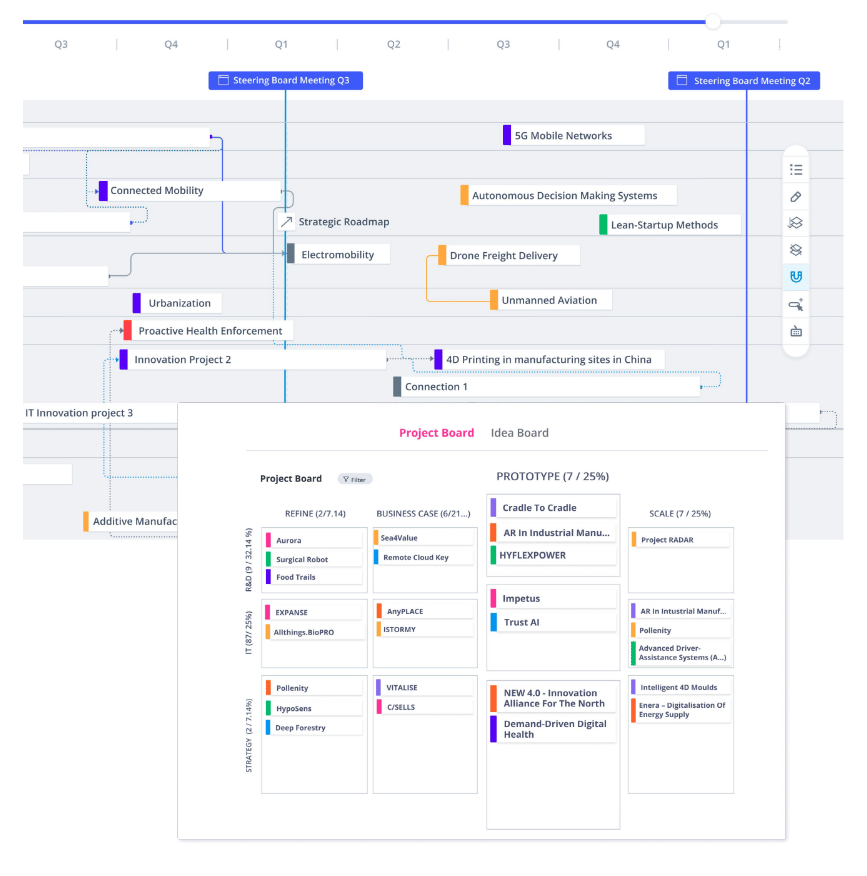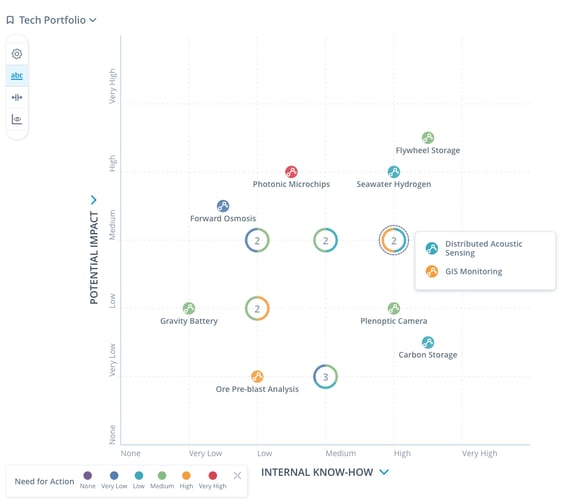Innovation is not just about technologies and ideas. What matters is getting your product out, taking it from concept to the market. Around the world, there are thousands of technologies collecting cobwebs in R&D labs. So, how do you commercialize your technologies, so they see the light of day?
If your business wants to bring technologies to market faster than competitors, the biggest obstacles might be internal complexity and lack of buy-in. Let’s go through six changes in approach that can accelerate technology commercialization at your company.
1. Involve different departments to connect the dots
Commercializing an innovation requires collaboration, but many companies don’t have a single source of truth to connect the dots between teams. The consequence of that is that R&D might, for instance, develop a technology idea that doesn’t have buy-in from marketing or sales because it doesn’t align with their vision and way of working. This human aspect of innovation is something Prof. Andy Wynn has described in a podcast interview with ITONICS:
If your job is taking innovation to market, then you're going to need to interact with all sorts of people: the operations manager, the sales manager, the marketing director, the finance guy, legal, CEO, CTO, etc. Depending on the nature of your role, you might be working with investors or with external suppliers, customers, or even local government if you're going to build a factory. Now, that's a huge amount of people, all with different objectives, and all of them have a role in making your project a success or not.
Often, innovations are not just the physical products themselves but involve a new business model, which will likely require a major shift for departments in your company. Imagine this scenario: a medium-sized manufacturing company runs an ideation challenge. The idea chosen as the winner is to enhance their physical goods with a digital application based on a subscription model. Commercializing this idea will challenge departments such as sales and customer service because it’s a transition from a traditional model to ongoing service and recurring revenue. If everyone does not come together, give their input, and recognize what transformation is required, commercialization will fail.
Getting input from various departments can’t just be an afterthought. It’s an essential part of the innovation process that increases the chances of successful commercialization. A study by McKinsey found that winning companies deploy new products and services quicker by being more collaborative and agile than their peers. Of the top companies, 58% were adept at collaborating across functions, and 54% innovated continuously to cut down time to market. Such an agile collaborative approach requires a software solution where insights and opinions from different teams can be integrated from the onset of the innovation process all the way through to market launch.
2. Establish a technology commercialization process
Companies that lead in commercialization don’t approach innovation as a freeform creative endeavor. Innovation leaders treat commercialization as a highly structured process, similar to the principles of improving manufacturing quality. They set measurable goals for ongoing improvement, develop the necessary organizational skills, and encourage teams to take bold action.
 If your innovation processes are too complicated to measure and monitor, that can be a significant barrier to swift technology commercialization. Companies can tame this complexity with software designed to streamline the path from concept to commercialization to cash. ITONICS offers such a solution in the Portfolio tool. You can use it to optimize your technology portfolio and steer progress with standardized workflows. Visualize innovation projects on the Roadmap, connect dependencies, align efforts of all the departments involved, and mark key milestones towards commercialization.
If your innovation processes are too complicated to measure and monitor, that can be a significant barrier to swift technology commercialization. Companies can tame this complexity with software designed to streamline the path from concept to commercialization to cash. ITONICS offers such a solution in the Portfolio tool. You can use it to optimize your technology portfolio and steer progress with standardized workflows. Visualize innovation projects on the Roadmap, connect dependencies, align efforts of all the departments involved, and mark key milestones towards commercialization.
3. Build capability to bring new products to market
A common pitfall for many organizations is the misalignment between innovation ideas and what the company is actually capable of bringing to market. They run ideation challenges every year where none of those ideas get anywhere near commercialization. That demotivates people. So, you have to ensure that the concepts the business is pursuing align with the company’s strengths and expertise.
Sure, sometimes you’re going for a moonshot: a seemingly insurmountable challenge involving a disruptive technology that reaches beyond what the company is currently capable of. But even then, the smart approach is to assess the gaps in the company’s capability portfolio and ask what is the expertise that need to be strengthened. Then plan and track that capability development as if it’s an innovation project in itself. That’s something you can do with ITONICS software. Ask experts within your organization to evaluate technologies, then map them out as circles on the Matrix with the x-axis indicating internal know-how and the y-axis set to potential impact. The technologies that end up in the top left quadrant are clearly attractive to the company, but beyond current expertise, so lay out a plan on the Roadmap to build the needed capabilities for commercialization.

4. Measure your company’s commercialization success rate
They say you can’t measure what you can’t manage. That’s not always the case, but it does highlight the importance of using a defined metric to measure your company’s ability to commercialize technologies. The recommended metric is your innovation project success rate. It evaluates the company portfolio in terms of factors such as project completion, commercialization, and achieving key milestones. Break it down by either technology area or market segment. Doing such an analysis helps identify where the company excels or where it needs improvement. This then equips you with the information required to adjust and optimize resource allocation.

Take a transparent approach within your organization to measuring innovation project performance. That helps when it’s time for tough decisions about which projects receive funding and which don’t. You can use the ITONICS to create a shareable overview of your entire innovation portfolio, assess resource usage, and see which projects are at risk.
5. Communicate the opportunity clearly
When you’re exploring an emerging technology, there’s a common pitfall of getting stuck in the weeds of how the technology works. Some people revel in this complexity. But in order to champion a technology for commercialization inside your organization, you must keep it simple and communicate what the technology does, not what it consists of. This ability is crucial to get others on board. Communicate what the technology does and how that aligns with the overall goals of the organization. Presenting your innovation plan with abundant data and technical specifications may turn your colleagues into antagonists. Instead, take a collaborative approach, and ask others for help to make them realize they have a stake in the outcome. You’ll struggle to commercialize a technology without the support of internal champions. Whether it’s securing buy-in from the board or tapping into the expertise of engineers, you need people who will advocate for the project.
6. Actually prioritize innovation
The final tip sounds so obvious that it doesn’t seem worth stating: make commercialization an explicit priority. Companies that just pay lip service to innovation, face the consequences when their competitors eventually outpace them. Industry leaders put commercializing technology high on the corporate agenda. Innovation is not a task to be relegated to a corner of the R&D lab. Turning technologies into viable products and services requires collaboration, diverse skill sets, and cross-departmental buy-in.
Ultimately, it's not the technology itself that’s the key to successful commercialization. It’s about reducing complexity and aligning a wide range of people to that goal. To see how ITONICS can help your company establish a smoother innovation process from concept to commercialization, book a demo with our experts today.











